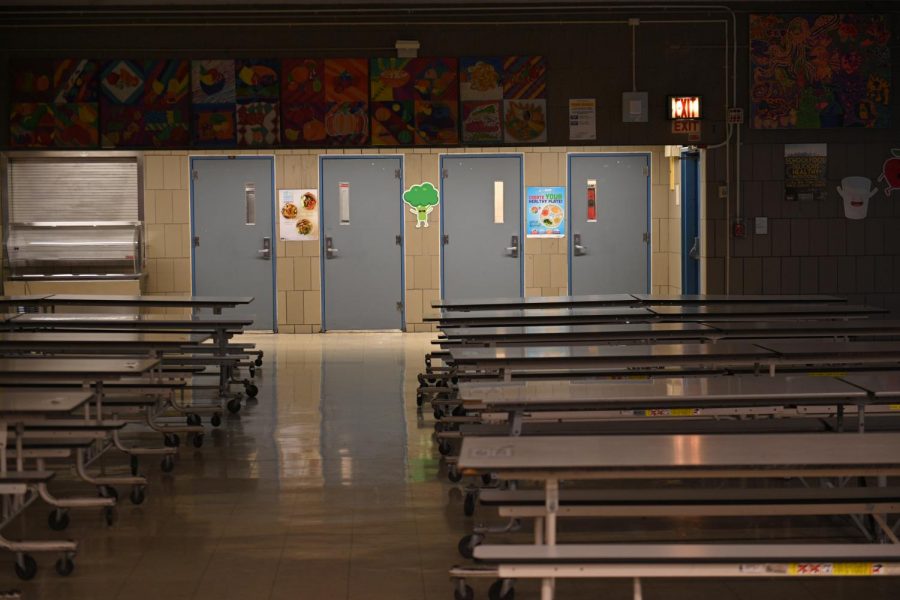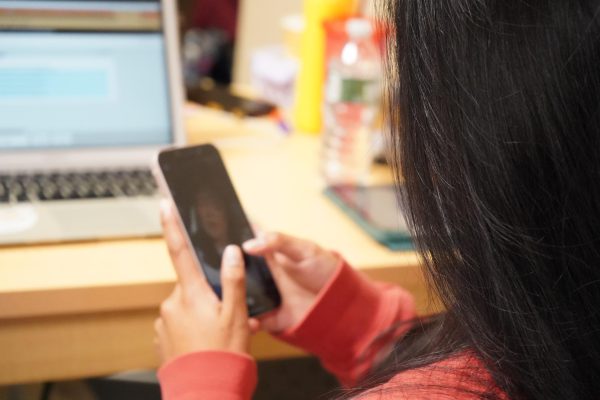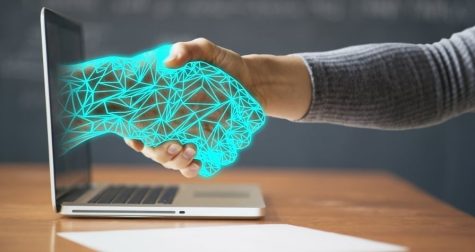Remote Learning Proves to be Challenging For All
Empty schools and empty chairs. The pandemic has shifted everything in the world, making this year’s learning experience one of the most challenging obstacles in the history of American education.
“Time management! Time management for high school kids is the biggest issue in my home. There’s still a bell schedule, but no bell, so a timed test opens at a specific time and closes at a specific time but if a child is doing work from the last class they just work until they finish the assignment and not until the “period is over” because there’s no bell.”
Cherise Reese, 40, from New York, is just one of the many parents who are struggling to manage a proper schedule for school and home duties.
“My kid isn’t paying attention to the time unfortunately and I can’t be the human bell I’m working. So I’m going to start using Alexa as his bell and program her to say when class is over.”
She also mentions internet connection is often lost during class and has been an issue as well.
On Nov. 19, it was announced by Richard A. Carranza, the current New York City Schools Chancellor of the New York City Department of Education, that students would once again transition to fully remote learning. School buildings including all New York City public schools temporarily closed for teaching and learning, leaving parents in distress.
Jacqueline Tapia, who lives in the Bronx, works overnight as a security officer at the World Trade Center. She finds it hard to have a proper night of sleep now that her son is doing remote learning.
“This pandemic did not only affect people’s lives, and jobs, but children’s learning. My 8-year-old hates doing any work, he only focuses on math and he gets frustrated, and me working overnight by 2 p.m., I am overwhelmed.”
***
She recalls passing by her school with her mom and seeing do not cross signs on the playground of her school.
“It was scary and It was pretty hard at first. I learn better when I’m face to face with my teacher.”
A fourth grader, Emily Souza, goes to school in Mamaroneck, New York. She began remote learning back in April.
Souza’s mother, Regiane Andrade, had to quit her job to help her daughter with remote learning. She says math is not Souza’s strongest subject.
“Math is the hardest to learn over Zoom. If we were in class and I had a question, I could ask the teacher right away, and now I have to wait for her to answer in the chat-box.”
Andrade says the long hours of sitting in front of a computer screen makes it hard for Souza and her classmates to maintain focus.
“The teacher gets annoyed sometimes because the students will just call out and have nothing to say, some students don’t raise their hands or follow instructions, and some kids are always distracted.”
To add to the list of difficulties, many teachers and students are still grappling with technology issues, making it tougher on both ends. Souza has experienced some odd moments on her zoom learnings.
“One time we were on zoom waiting for 40 minutes for the music teacher to show up, and we were all just talking to each other. Sometimes Zoom will just stop working, and it kicks the teacher out; these past few weeks her internet hasn’t been good, and if she’s gone for too long the kids start to freak out.”
With COVID-19 cases increasing, Andrade feels safer continuing Souza with her remote education, leaving adapting as the only option.
“I started getting used to it so it got easier, but I still wish I could go back to school, I would be able to see all my friends, I miss being able to sit next to them, and I miss the teachers being there to help us anytime we need.”
Andrade stopped working in March. She’s using this extra time to accompany Souza in her zoom classes and any homework assignment. She believes that parents should use this time to connect more with their children.
The pandemic caused many parents to lose their jobs and some parents had no choice but to quit their jobs to assist with their children’s learning needs.
Jessica Vasquez, a working mother from Staten Island, had to leave her job after 14 years of working for her company to help her 8-year-old who’s in third grade.
“I have been home since April with schools being closed along with summer camps. Some schools are open but there is no afterschool available so I am not able to return to work. Everyday something is changing in regards to school our kids need proper education and parents need to work, it’s a disgrace.”
Rachael Campbell, a mother from Queens, has been doing remote learning with her son from last March to early April. She says her experience with remote learning hasn’t been much of a challenge for her and her son.
“His teacher this year is very tech-minded, and she has helped so much with coordinating these apps as well as an online learning time for her students. As it can be very tedious, I enjoy the time home with him. After coming home from work I use to never have the time to review homework properly at night”
***
Research done by the Northwest Evaluation Association (NWEA) a global research-based not-for-profit educational organization, predicts that students from grades third through eighth grade will be the most impacted by COVID closures and transition to remote learning.
The research also predicted a major impact on children’s mathematical education.
According to the NWEA, the projections in figure 1 shows the average academic growth trajectory for mathematics, and figure 2 shows the same trajectory for reading.
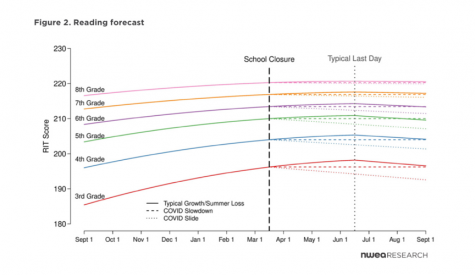
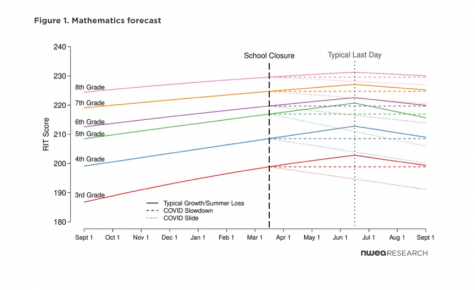
The solid lines in the graph show the average academic growth in a normal year. The average academic growth shown as the curved lines varies across the academic year with declines seen on the last day of school through summer. Steeper declines are commonly seen in mathematics.
The above graphs are based on a quadratic trajectory across 2017-2018, the dashed line shows what a school year is projected to look like with COVID-19.
The NWEA estimates suggest students will return in fall 2020 with roughly 70 percent of the learning gains in reading relative to a typical school year.
Additionally, the NWEA suggests that in mathematics, students are likely to show much smaller learning gains, returning with less than 50 percent of the learning gains and in certain grade levels, nearly a full year behind the normal rate.
A recent study by the NWEA on the COVID-19 impact on student learning, the NWEA collected data from more than 4 million students from grades 3-8. Subsequently, researchers noticed a large fraction of student groups missing from this data, the results showed most of the groups missing are part of underserved communities.
“Across subjects and grades the same pattern was observed, a large proportion of students were African-American and Hispanic or Latinx, students with lower achievement, and students in school serving higher concentration of socially-economically-disadvantaged students,” said Beth Tarasawa, Executive Vice President of Research.
NWEA suggests that missing data can be the result of school districts who had their funding impacted by the pandemic and their equitable access to high quality teaching and learning.
Brittany Urie, the Founder of the learning center, Project Safe, says differences in resources for lower income communities like in Mount Vernon, New York is uncanny.
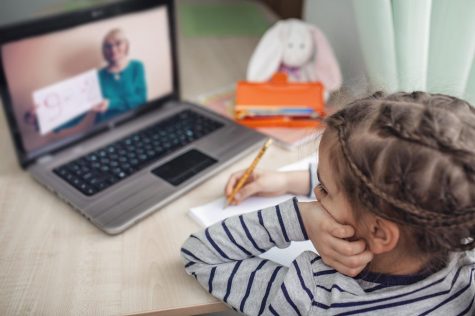
***
The pandemic has continued to affect online learning in more ways than one. Students are getting bombarded through laptops, it’s hard for them to keep up. But, it’s also quite challenging for teachers, professors, and administrators as well. Deciding on the new curriculum, and dealing with new technological challenges is no easy feat.
While teaching remotely, Tanya Cook, a sociology professor at the Community College of Aurora, Colorado, has worked tirelessly to make this school year an effective one for her students.
“It’s more difficult to feel like part of a community when everyone is in a different space. I also don’t have the ‘live’ feedback because often students leave their cameras off, which is fine, but I can’t read body language or know if someone is zoning out as well. It also shifts what kinds of activities I can do. In the past, I’ve done some fun in-class games/simulations that I haven’t been able to figure out how to translate to an online format.”
With such big changes made, difficulties have also risen throughout.
“I think the biggest change is that I cover more material because there’s less time/space for class discussions. This is not necessarily a good thing, though, as students get a lot out of talking to one another. I am trying to include activities during online class because just listening to someone via Zoom is pretty boring, I’m sure,” she says.
Cook does enjoy the playback feature of Zoom since the classes are recorded for the students to rewatch as need be. She recognizes that the lack of in-person teaching means she misses out on some of the student’s questions, but the opportunity for them to rewatch lectures can help them with their understanding of the material.
Distance learning at a college level does have its perks, mostly being the independence of the students allows the teacher to actually just focus on the material and how it’s being relayed. Cook says that was definitely an easy transition in that way because she always feels her students are independent no matter the circumstances.
However, many different issues from the pandemic do plague many students and it can be difficult to balance it all.
“I think students are pretty good at being independent but it’s difficult to keep everything straight for all of us, in terms of schedule/expectations right now, plus many of our students work and/or care for family members,” she said.
Being a sociology teacher, Cook does see why it can be beneficial for students to learn in person but she isn’t afraid of technology.
“The students and I have also had to learn a lot of new technology and I think learning new digital skills is actually a positive for all of us, in terms of being better suited for the workforce. Students are also better at emailing or getting in touch to ask questions.”
Though she welcomes technology and enjoys learning it she does note that the transition could have been better.
“Not a smooth transition, for sure! Luckily, I was pretty comfortable with the technology we had available; that said we initially had WebEx which kind of stinks for live discussion; I used that over the summer, but only 4-5 students would come to each class. All of us instructors basically demanded the college get a zoom so that we could do breakout rooms, and I think it’s much more user friendly for everyone.”
All of these challenges have helped Cook continue to grow as a person and educator while continuing to be a great resource for her students.
“The biggest issue for our students, however, and some of our instructors, is reliable internet access and access to a computer that can support online classes. We did our best to help students with this but I know we could do better. It’s tough because budgets are a mess right now. Many of our students have to also share laptops or internet access with other family members and that can make it difficult to do online coursework/participate in class.”
She has taken the time to look through her curriculum and adds time where she needs to be working. “I’ve gotten better at using the various technologies, and I am also doing a lot of training and professional development about how to be anti-racist and intentionally create an inclusive classroom in general, but also with respect to the online format.”
Distance learning and teaching continues to have challenges, she does think the situation might get better but definitely acknowledges the hardships and the position it’s left people in.
“I think we are all getting better at online communication but the main issues here I think are the overall stress of the two pandemics – COVID-19 and racism, and the financial resources issue that affects both students and instructors. Mental health issues and health issues, from covid or family members having covid, is also a complicating factor for many students and instructors.”
The remote learning model is very difficult for students, professors, and even administration members. The people who run education services have now been faced with incredible new problems throughout the pandemic and are having to come up with new ways to solve them.
Alfonse Davino, Principal of Thomas Jefferson elementary school in Westchester has had to face more in his second year as a principal than he ever thought he would have to. The pandemic was thrown upon everyone rather abruptly and schools across the nation had to make decisions of how to proceed, and of course deal with the new challenges that have come about.
“Staffing concerns and new social distance guidelines have made it difficult to operate on a regular schedule. As well as, staff and families heightened anxiety and stress levels have also presented some challenges,” he says.
Zoom has become the forefront of all communications through COVID-19 even for schools and it may have come with learning curves for some. Many other communication platforms are being utilized, all depending on the group of people using them.
“I used Zoom to collaborate with my colleagues across the region. It went well. We utilized breakout sessions for small group discussions. My staff, students, and I use the Google platform to conduct live instructional sessions and all meetings. It has presented challenges at first with muting and muting people but we are getting used to it now and it is working well,” Davino added.
Online communication platforms have taken the world by storm, they have filled a consumer’s need in many different workforces and it will take schools time to learn how to handle and integrate technologies properly.
An administrator is responsible for the whole school, faculty students, and more. Their work never ends, and now that it can be easily taken home, the job is non-stop thanks to accessible files utilized by distance learning.
Issues and complaints will come about with the introduction of anything new and Davino has experienced some of those.
“The Internet is slow or dropped sessions have occurred. There is a learning curve associated with any new technological device or program.”
Davino’s school enrolls ages 4-11 and curriculum changes have had to be made, like in the case of their new ELA program and there are age-specific issues that arise.
“The younger students need additional assistance to navigate the technology at home.”
Davino said that ELA and Music are among the most affected subjects, students and faculty have to navigate this all every day.
Parents, and especially in this age group have complained about the difficulties of maintaining a learning environment at home, and Davino has heard some of these complaints. As the school year continues, he is confident that all major issues will or have been already fixed.
Many issues and problems with distance learning have been addressed at Davino’s school and they will continue to work out issues as they arise.
“Most of the issues have been resolved. This is just difficult to manage or sustain for a long period of time. Some instructional strategies and technology advancements will continue even when we are back to normal.”
***
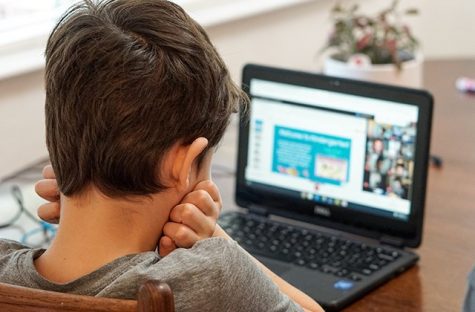
Due to the COVID-19 pandemic, many grade school students have been switched to remote learning via the internet. It’s been challenging for all students of all ages from Pre-K to high schoolers. But a group of students who have been uniquely affected by the pandemic is special education students.
According to the National Center for education statistics, “In 2018–19, the number of students ages 3–21 who received special education services under the Individuals with Disabilities Education Act (IDEA) was 7.1 million, or 14 percent of all public school students. Among students receiving special education services, 33 percent had specific learning disabilities.”
That is a big percentage of kids not getting the education they need to succeed.
Remote learning from home has been a detriment to special education, as special-ed students thrive more off of one on one interaction with their teachers. Remote learning has also been a struggle for special ed teachers as many teachers have been finding it harder to keep the attention of special ed students through zoom.
Special education teacher Stephanie Norwick, of Public School 160, is finding challenges in her routine as a teacher.
“What I find is the hardest for me as a teacher and for them, as students are some of them are small classes, small class services, so they go to a 12 to one to one classes, or if they’re an ICT for two teachers, it’s not a big group of kids, but I have a big variety of learners.”
Norwick says that having such a wide variety of learners in one virtual setting can be exhausting at times.
“Unfortunately, there’s a pace to keep up within the meeting. And even if I see them after the meeting, by that point, they’re so tired and I don’t want to stay overwhelmed. They’re so overstimulated by everything else. We’ve done that whole hour, that holding them an extra 20 minutes. Sometimes it’s counterproductive. You know, it’s hard for them.”
According to Brain Balance Center.com, kids at the age of six have an average attention span of 12 to 18 minutes, while kids who are age eight only have an average attention span of 16 to 24 minutes. And then 10-year-old kids who are the upperclassmen elementary schoolers average attention span is 20 to 30 minutes.
Norwick knows this and tries different techniques to keep her students on track during their lessons.
“I try to use different platforms. I’ll use Flipgrid, which is a way for them to record videos. I will also use Screencastify so that any assignments I post will have a video of me explaining it.”
Additionally, Norwick has had to adapt and learn how to use new applications to engage her students during class.
“I use Google Meet The Staff, that’s another way to have participation. Kids thrive on hands-on, and I’m very tactile, I like to have things for them to touch and see. I try to have platforms that do that for them, because it’s a little harder when they’re tactile audio and visual learners when you need a multi-modal approach to things. We try to get creative, because that’s a big missing piece in there. So we, the teachers have been doing a really good job without having different platforms for the kid to compensate for that lack in the classroom.”
Corey Mitchell of Education Week.org says it is vital for special education students to be learning alongside their teachers and not at home with the parents.
“More than three-fourths of students with disabilities spent most of their day in traditional classrooms with peers who are not eligible for extra support. The Individuals with Disabilities Education Act mandates that children who receive special education services should, whenever possible, be taught alongside students who are not eligible for special education services.”
“General classroom teachers must communicate with special education specialists to review and determine what supports students need, and how and when they receive those extra supports,” he added.
It has also been tough for after-school programs that help tutor special needs kids. When COVID-19 was at its peak back in March, many after-school programs were shut down. One of those places was Pine Grove Country Day School, a daycare and after-school center for kids from pre-k to 8th grade.
Robert Amendola, a teacher’s assistant at Pine Grove , says it is hard for special education students to not have the proper after-school tutoring
“The hardest thing is probably teaching them the social and emotional skills they sometimes don’t have. When they can’t relay how they are feeling or what upset them is challenging.” Amendola said “I think it was bad for them. Months out of school, no practicing social skills. It did a lot of damage to the children and some regressed.”
During this past fall, schools in New York state opened back up for special education students. The New York state education department mandated that schools could stay open for students with disabilities as the state realized that they must consider the needs of each student to get the best education. Pleasantville High School in Westchester, New York, which was one of the areas in New York state that had one of the highest confirmed COVID-19 cases opened its doors this past semester for students with disabilities.
Michael DeMascio, a special education teacher’s aide at Pleasantville High School, said that “now this year the kids have the option if they want to stay home and do it virtually they can or if they feel safe they can come to in-person classes at the school.” DeMascio also went on to say that “it has been an adjustment for the teachers but it’s been an even bigger adjustment to the students because when they’re at home they just want to relax and they can get easily distracted.”
It is important that students with disabilities such as autism, dyslexia, ADHD, or any other learning disability get the necessary help so they can get the best quality education. Many kids are being robbed of proper education due to the pandemic and it’s a big reason why states all over the country are opening up their public schools for the students who need it the most.
Special education students can’t go a long time with the current platform of virtual learning, they need one on one interaction with their teachers.
This has been an unprecedented time in the country. It was the year of the unknown. It wasn’t just a struggle for students and teachers, but for the parents as well while everyone who tried to navigate learning from home.
As 2021 approaches, there are still fears surrounding COVID-19 and the challenges of remote learning. Without a definitive end in sight, schools will have to keep adapting to a distanced learning model for now.

A die-hard sports fan who is eager to learn more about the sports media industry. His dream is to one day work for a big sports news outlet. He is a die-hard...

Jadeen Mercado is a senior who loves all things entertainment!
She writes a column called Jadeen's Scene
She can be reached at [email protected]...

Nicole Alarcon is a senior at Mercy College, majoring in journalism. Born in São Paulo, Brazil, she moved to the United States at 10-years-old.
Nicole...



